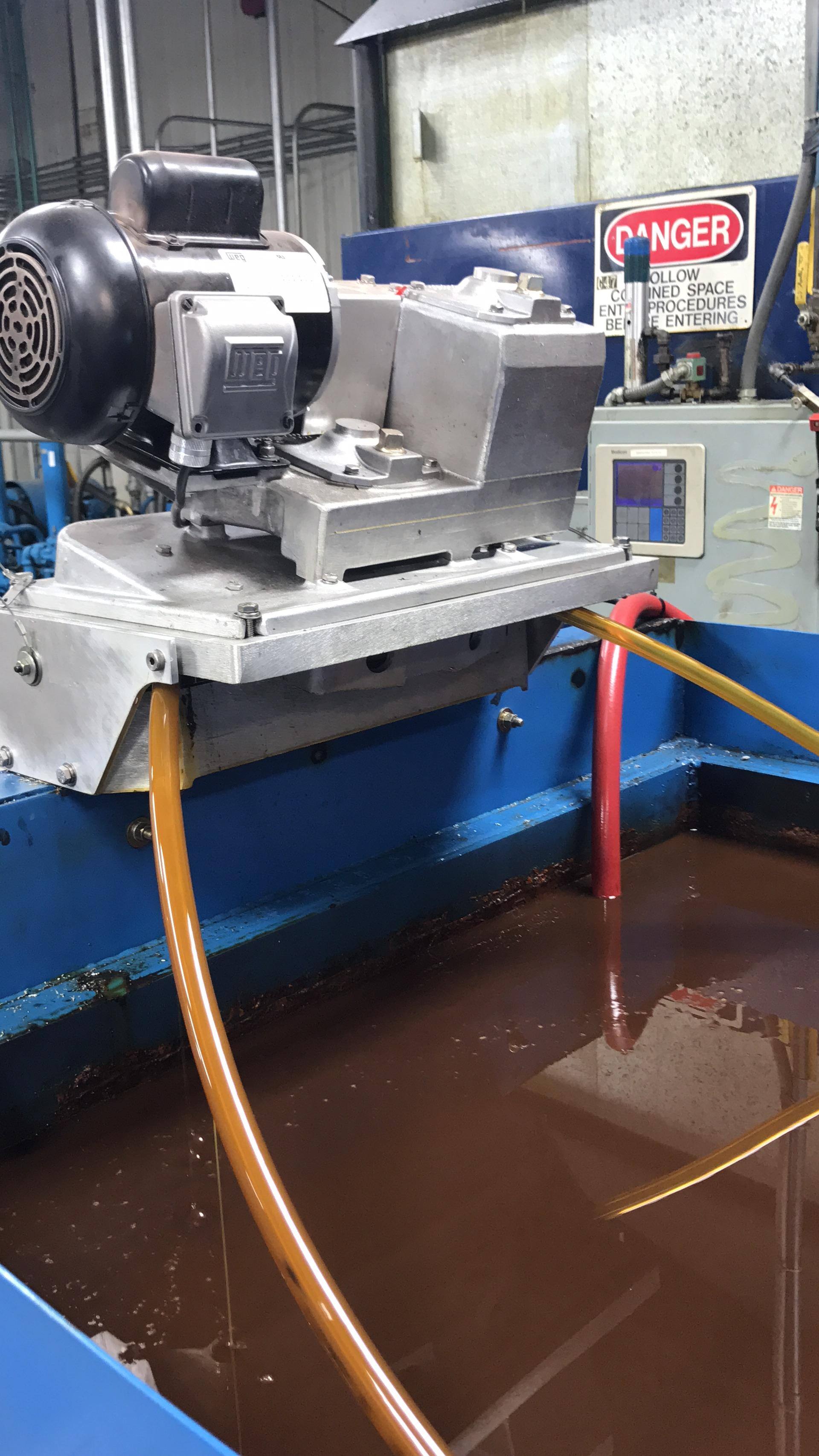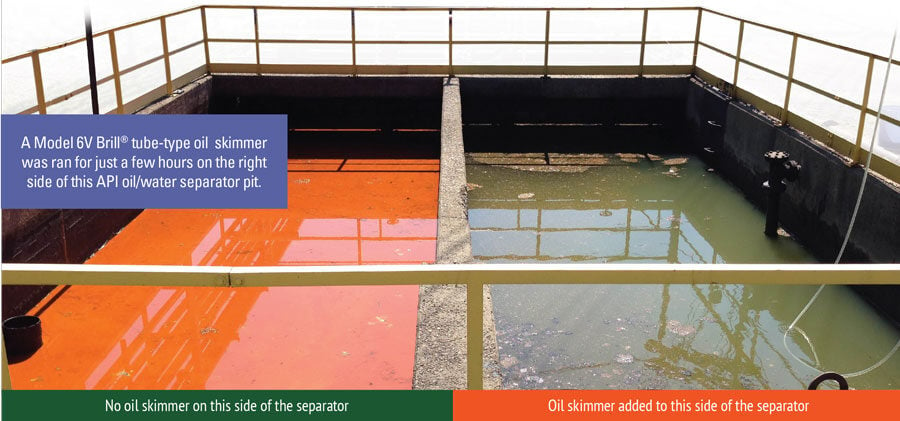Best Way To Remove Oil From Water
If fats, oils, or grease are accumulating in your process or wastewater, Oil Skimmers, Inc. offers the solution you need: a combined oil-water separator and oil skimmer.
Designed for efficiency and durability, our systems are built to operate 24/7—or as your application requires—providing a cost-effective solution across a wide range of industries, including:
- Food & Beverage
- Manufacturing & Industrial
- Petroleum & Chemicals
- Marine & Transportation
- Mining & Heavy Equipment
- Power & Utilities
- And many others
Contact us today to discover how Oil Skimmers, Inc. can provide a long-term solution to your oil-water challenges.
Ready to see if this solution is right for you?

Separate and Remove Oil
The SAS® Tank is an Oil-Water Separator with an Integrated Oil Skimmer
Unlike other oil water separators, the SAS Tank is equipped with a Brill® tube-type oil skimmer (AKA rope skimmer) for Active Oil Removal® that continuously removes the separated oil. An integrated decanter returns any water or coolant collected by the skimmer back to the application. The decanting process ensures the least possible percentage of water in the recovered oil.
Take advantage of our free application assessment.👇
Get a Free Assessment
"Conventional methods of pumping oil/water mixtures are much less efficient than using an oil skimmer. That’s why we bought into the technology. It’s an established technology that works effectively with minimum maintenance."
Andrew Scano
Oil Skimmers, Inc. Customer
Variables Affecting Oil/Water Separator Performance
If not addressed in the right manner, at the right time, oily water can have serious implications on business success, compliance, and more importantly, on our environment. Luckily, there are tools available to effective oil separation and removal.
Proper Design
Oil/water separators must be designed to accommodate established maximum flow rates as well as variables such as stormwater runoff, so the flow doesn’t exceed design capacity. Excessive drainage of stormwater to an oil/water separator could significantly impair its operation and efficiency.1
Frequency of Maintenance
To function properly, oil/water separators require ongoing service and maintenance by trained personnel. Frequent system inspections are necessary to prevent operational and mechanical failures that may cause leaks or accidental discharge of oil into water.2
Emulsifying Agents
In many industries, detergents and soaps are used to remove oily grime from equipment or vehicles. However, wastewater containing detergents and soaps emulsify with the oil and significantly slow down the oil water separation. And excessive use of detergents can render a separator ineffective by completely emulsifying oils into the wastewater stream, allowing them to pass through the separator.
Sludge Build-up
Over time, oil accumulates in the sump and combines with dirt and particles creating a sludge build-up that is heavier than water. The oily sludge falls to the bottom of the sump where it is then pumped through downstream oil/water separators getting trapped inside the piping, oil water separator media, and auxiliary controls causing an interruption in the facility’s monitoring equipment, ultimately increasing operating and maintenance costs.
Oil Build-up on the Surface of the Oil Water Separator
Traditional oil water separators allow the oil to rise to the top and exit through a slotted pipe or overflow weir into a collection vessel. These methods require monitoring and manual adjustment, demanding time, and labor from maintenance personnel. If left unmonitored, which most seem to be, a layer of oil can build up on the surface, causing a host of other maintenance and performance problems, including:
- Lack of oxygen from reaching the water’s surface, resulting in the formation of anaerobic bacteria that can cause skin irritation, clog coalescing media, and emit foul odors.
- Heavy sludge formation on the top oil layer of the oil water separator from dirt and debris collecting in the oil. Eventually, the surface sludge tends to sink, affecting the performance of coalescing media and disrupting the operation of the separator.
- Risk of oil “flush out” … where any sudden or heavy inflow of water (for example, from an increase in production or from stormwater) can exceed the separator’s capacity, washing out the oil layer that has gathered on top and causing it to mix with the clean effluent.
- “Crowding” … where the oil layer takes up an increasing space in the separation chamber, reducing the overall separation area and thus reducing the functionality and efficiency of the separation process.
Faced with challenges like these, organizations often struggle with how to best optimize the performance of oil/water separators, so we put our decades of application knowledge to work. Our engineers identified a commonality within the five variables affecting oil/water separator performance, unintended oil escaping the oil water separator. Recognizing this operational inefficiency, Oil Skimmers, Inc. developed the concept of Active Oil Removal™ to prevent residual oil inadvertently entering downstream.
Active Oil Removal™ provides continuous oil removal from the water’s surface at the point of separation ultimately reducing equipment maintenance needs, improving operations of down-the-line filtration equipment, enhancing environmental compliance, and increasing cost savings. The integration of a Brill® Type Oil Skimmer with a Free-Floating Collector Tube™ has been incorporated into several existing oil water separators and has proven to maximize the effectiveness of oil water separators within a variety of applications.
Our oil removal experts are a phone call away and would love to learn more about your application. With our team of engineers, and variety of mounting options available to fit your application, we are confident a solution is waiting for you.
Contact us today @ 440-237-4600 or visit Brill® Tube Type Oil Skimmers to learn more!
1 US Army Corps of Engineers (January, 2010). AED Design Requirements: Oil/WaterSeparators
2 US Army Corps of Engineers (January, 2010). AED Design Requirements: Oil/WaterSeparators
Get a free assessment today
Our oil removal experts are a click away and would love to learn more about your application. With our team of engineers, and variety of mounting options available to fit your application, we are confident a solution is waiting for you.
.png)

